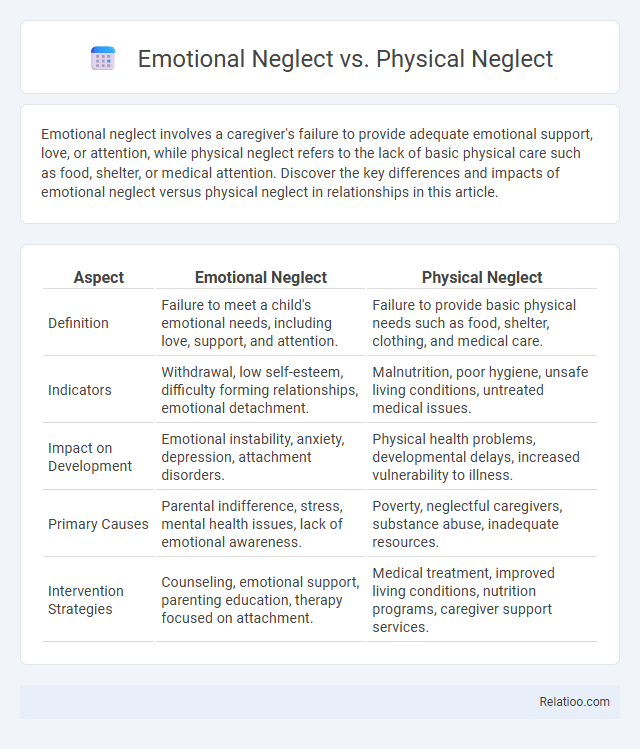Emotional neglect involves a caregiver's failure to provide adequate emotional support, love, or attention, while physical neglect refers to the lack of basic physical care such as food, shelter, or medical attention. Discover the key differences and impacts of emotional neglect versus physical neglect in relationships in this article.
Table of Comparison
| Aspect | Emotional Neglect | Physical Neglect |
|---|---|---|
| Definition | Failure to meet a child's emotional needs, including love, support, and attention. | Failure to provide basic physical needs such as food, shelter, clothing, and medical care. |
| Indicators | Withdrawal, low self-esteem, difficulty forming relationships, emotional detachment. | Malnutrition, poor hygiene, unsafe living conditions, untreated medical issues. |
| Impact on Development | Emotional instability, anxiety, depression, attachment disorders. | Physical health problems, developmental delays, increased vulnerability to illness. |
| Primary Causes | Parental indifference, stress, mental health issues, lack of emotional awareness. | Poverty, neglectful caregivers, substance abuse, inadequate resources. |
| Intervention Strategies | Counseling, emotional support, parenting education, therapy focused on attachment. | Medical treatment, improved living conditions, nutrition programs, caregiver support services. |
Understanding Emotional Neglect: Definition and Examples
Emotional neglect involves the persistent failure to respond to a child's emotional needs, leading to feelings of invisibility and unworthiness, unlike physical neglect which entails the lack of basic needs such as food, shelter, or medical care. Examples of emotional neglect include ignoring a child's need for affection, failing to provide comfort during distress, or neglecting to recognize their achievements and feelings. Understanding emotional neglect is crucial for your ability to identify its subtle impact on mental health and relationships in both childhood and adulthood.
Physical Neglect Explained: What It Involves
Physical neglect involves the failure to provide necessary basic needs such as food, shelter, clothing, hygiene, or medical care, which affects a child's overall health and development. Unlike emotional neglect, which centers on the lack of emotional support and affection, and emotional abuse that includes verbal harm or manipulation, physical neglect directly impacts a child's physical well-being. This form of neglect can lead to malnutrition, poor growth, untreated illnesses, and increased vulnerability to injuries.
Key Differences Between Emotional and Physical Neglect
Emotional neglect involves the failure to provide adequate emotional support, affection, or attention, leading to feelings of unworthiness and impaired emotional development. Physical neglect refers to the lack of basic physical needs such as food, shelter, clothing, and medical care, resulting in compromised physical health and safety. Key differences include emotional neglect impacting psychological well-being and attachment, while physical neglect primarily affects physical survival and bodily health.
Signs and Symptoms of Emotional Neglect
Emotional neglect manifests through signs such as low self-esteem, difficulty forming attachments, and chronic feelings of emptiness or worthlessness, which differ from the more visible symptoms of physical neglect like malnutrition or poor hygiene. Unlike physical neglect, which involves failure to provide basic physical needs, emotional neglect is characterized by a consistent lack of emotional support, validation, and affection, resulting in long-term psychological impacts. Awareness of emotional neglect symptoms enables early intervention to address developmental and relational challenges stemming from this often overlooked form of maltreatment.
Recognizing the Indicators of Physical Neglect
Physical neglect is identified through indicators such as consistent hunger, poor hygiene, untreated medical conditions, and inadequate clothing for weather conditions. Children experiencing physical neglect may exhibit frequent absences from school, developmental delays, or appear unsupervised and unsafe. Recognizing these signs early helps differentiate physical neglect from emotional neglect, which primarily involves the absence of emotional support and affection rather than physical care.
Short-Term Effects of Emotional and Physical Neglect
Short-term effects of emotional neglect include feelings of worthlessness, anxiety, and difficulties forming secure attachments, while physical neglect often results in malnutrition, poor hygiene, and increased vulnerability to illness. Emotional neglect disrupts your ability to regulate emotions and communicate needs effectively, whereas physical neglect endangers your physical health and safety. Both types of neglect compromise overall well-being, highlighting the urgent need for intervention and support.
Long-Term Impact on Children: Emotional vs Physical Neglect
Emotional neglect impairs a child's self-esteem and emotional regulation, leading to chronic anxiety, depression, and attachment disorders that persist into adulthood. Physical neglect, characterized by failure to provide basic needs like food, shelter, and medical care, results in developmental delays, poor health, and increased vulnerability to physical harm. Your child's long-term well-being is profoundly affected by both types, but emotional neglect often undermines psychological resilience more insidiously than the visible consequences of physical neglect.
Causes and Risk Factors for Neglect in Families
Emotional neglect often stems from caregivers' unresolved trauma, mental health issues, or chronic stress, leading to a lack of emotional support necessary for healthy child development. Physical neglect typically arises from poverty, substance abuse, or inadequate parenting skills, resulting in failure to provide basic needs like food, shelter, and medical care. Understanding these causes and risk factors helps you identify neglect patterns in families and promotes early intervention to protect vulnerable children.
Strategies for Prevention and Intervention
Effective strategies for preventing and intervening in emotional neglect, physical neglect, and emotional neglect emphasize early identification through comprehensive screening tools administered by educators, healthcare professionals, and social workers. Implementing trauma-informed care frameworks alongside parental education programs enhances caregivers' ability to recognize and respond to children's emotional and physical needs proactively. Collaboration across multidisciplinary teams ensures tailored support, fostering resilience in affected children and reducing long-term developmental and psychological impacts.
Seeking Help: Resources for Victims of Neglect
Victims of emotional, physical, or emotional neglect can access specialized resources like counseling services, support groups, and helplines tailored to their unique experiences. You can benefit from professionals trained to address the psychological and physical impacts of neglect through trauma-informed care and advocacy programs. Early intervention resources are crucial for healing and building resilience after neglect.

Infographic: Emotional Neglect vs Physical Neglect
 relatioo.com
relatioo.com